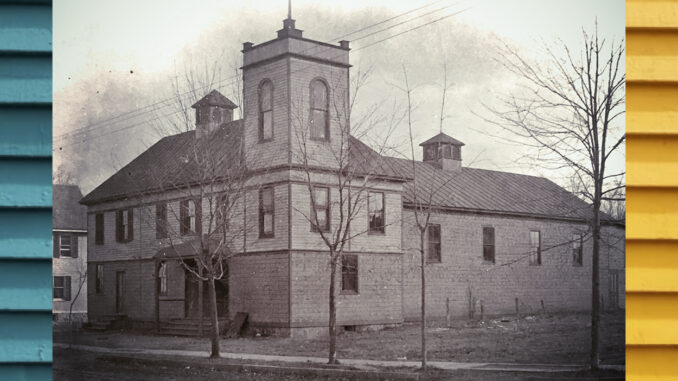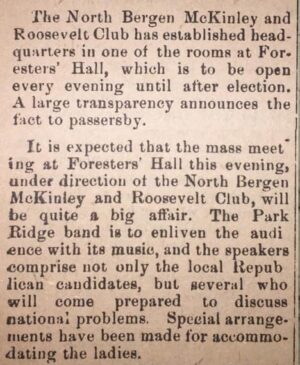
PASCACK VALLEY—The North Bergen Chapter was one of many McKinley and Roosevelt clubs that sprang up in cities across America in 1900 to promote the reelection of Republican William McKinley, former governor of Ohio, as president for a second term with New York Gov. Theodore Roosevelt as his vice-president. The club’s headquarters was at Foresters’ Hall in Park Ridge.
Foresters’ Hall was on Kinderkamack Road opposite Madison Avenue (across the street from where The James is today). The building belonged to a fraternal organization called The Ancient Order of Foresters, but it also served as a public meeting place in Park Ridge. This location figured heavily in the early history of the borough: This is where the idea of Park Ridge becoming a borough was first suggested in 1894 and where the voters gathered later that year to make it happen. Elections were held there, as were town meetings, graduations, banquets, dances, theatrical productions, and the first movies screened in Park Ridge.
“The North Bergen McKinley and Roosevelt Club has established headquarters in one of the rooms at Foresters’ Hall, which is to be open every evening until the election,” reads an announcement published in the Park Ridge Local, a weekly newspaper of the day, on Oct. 17, 1900.
That evening was to feature a large gathering, complete with a brass band and appearances by local candidates. The announcement states that “special arrangements” were made for accommodating the ladies. This was two decades before women were able to vote, and certainly in 1900 politics would have been considered a man’s game and wholly uninteresting to women.
That year’s presidential election was a rematch that featured the same candidates from four years earlier. The election of 1896 had seen McKinley defeat a young Nebraska congressman, 36-year-old William Jennings Bryan, in a hard-fought contest. In 1900, McKinley sought a second term and Bryan returned for round two.
When the vote took place on Nov. 6, 1900, the American people favored the sitting president. His first term had seen the U.S. rise out of an economic depression and emerge as a global power after a victory in the Spanish-American War. McKinley won 292 electoral votes and 51.6 percent of the popular vote to Bryan’s 155 electoral votes and 45.5 percent of the popular vote.

McKinley would not complete his second term. In September 1901, he was assassinated while attending the Pan-American Exposition in Buffalo, N.Y. In a 36-year period, three presidents had been assassinated in office. Months after McKinley’s death, 24/7 Secret Service protection for presidents was implemented—and remains the norm. The first recipient of this protection was Theodore Roosevelt, who ascended to the presidency and completed McKinley’s term before winning one of his own.
If you enjoyed this article, be sure to check out the Pascack Historical Society’s exhibit, “Pascack’s Political Past: A century of election memorabilia.” The display highlights the museum’s archive of political relics dating back to the mid-1800s, as well as some remarkable stories of elections from our region’s past. Visitors will see ballots and voting boxes dating to the 19th century, campaign memorabilia, political flyers and photographs, and learn about local polling places of yesteryear. It is available for viewing every Sunday from 1-4 p.m., now through November. Museum admission is free. The Pascack Historical Society is at 19 Ridge Ave., Park Ridge.
